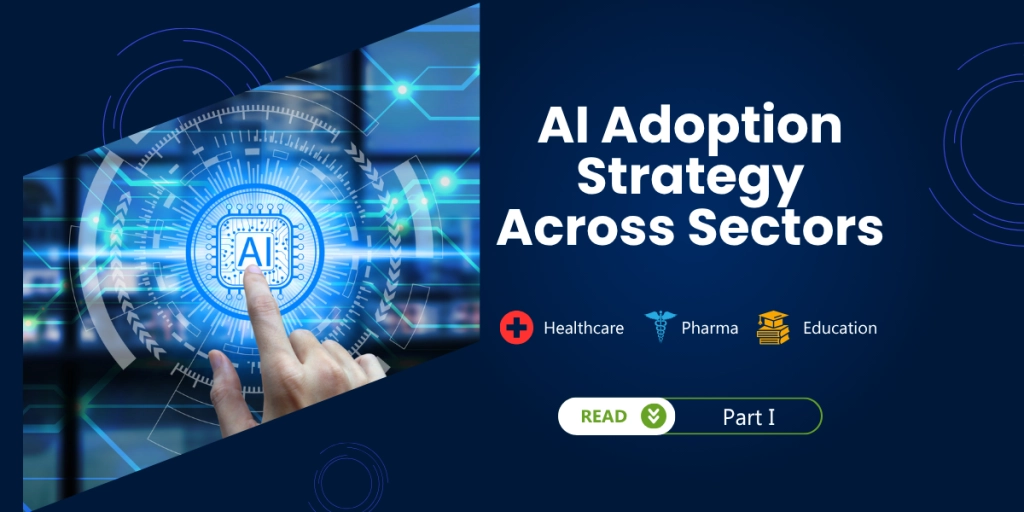AI Adoption Strategy Across Sectors (Healthcare, Pharma, Education) - Part I
Artificial Intelligence (AI) is persisting in our lives, both personal and professional. We use it every day, often without even realizing it, because almost every tool we interact with now has built-in AI capabilities. From email platforms that draft emails to meeting apps that generate real-time summaries, AI is becoming an invisible co-pilot in daily workflows. Some use AI for smaller routine tasks, like translating content or brainstorming ideas. Others are already applying it at scale to accelerate research or even optimize entire business processes. No matter how simple or complex the task is, AI is no longer a future possibility. It’s part of today’s operating system. And yet, many individuals and organizations are still far from using AI to its full potential. The tools might be there, but true adoption, where AI delivers measurable value and integrates into strategy, is still rare.
We recently conducted a simple poll asking: “Are you truly using AI to its full potential in your daily work?”
The majority of respondents admitted they are still experimenting. They are exploring what is possible, but haven’t embedded AI into their core ways of working, yet. They are testing, but not transforming, yet. This disconnect between AI usage and AI value is what needs to change.
The first and most important thing to understand is - AI will not replace you as a professional!
What it will do is boost your skills, and who knows, it might even make your boss rely on you more.
Just like computers or smartphones, AI is a tool. It doesn’t think for you, and it doesn’t remove the need for expertise. In fact, it uses your expertise to complete the tasks that you have given to it, freeing your time from repetitive tasks and giving you space to focus on higher-impact work. Professionals who embrace AI are not being replaced, but their skills are becoming more valuable.
Doctors are not replaced by AI-powered diagnostic tools, they are supported by them.
Researchers don’t disappear because AI summarizes literature, they move faster through data to make remarkable breakthroughs.
Educators are not undermined by AI-generated content, it helps them reach more students in more personal ways.
And from an organizational perspective, AI adoption will not make your employees lazy or encourage corner-cutting. On the contrary, when introduced properly, AI makes work easier and is done with pleasure, not threatens it. It helps people work smarter, not less, allowing professionals to focus on making high-value human decisions.
Of course, this only works if your teams know how to use AI effectively. That’s why structured AI adoption must always go hand in hand with the right training, frameworks, and support. When employees are equipped with the right tools and mindset, AI will lead to less mistakes, optimized processes and strategies, improved decision-making, saving time and money for the organization.
This is why AI adoption isn’t just a technical project but also a cultural shift. And without clear direction, many organizations fall into the trap of surface-level usage or fragmented experimentation that never scales into real impact.
In our previous articles, we have already explored key dimensions of the AI landscape:
No matter what is the industry, successful AI adoption follows a common path. Here's our proven framework, which we tried to describe in not-so-tech language:
On the other hand, when AI is related to business-critical goals, it becomes a useful tool instead of just something new and fancy.
✅ Tip: Ask clear, goal-oriented questions:
What problem are we trying to solve?
Where do we experience inefficiencies, delays, or bottlenecks?
What processes would benefit from more automation or better decision support?
What are we aiming to achieve – e.g., improve quality, increase speed, reduce costs, or enhance user experience?
✅ Tip: Ensure that your systems are cloud-ready and integrated enough to support AI tools; your data is structured, secure, and accessible, there are existing policies on data privacy and security; your teams know how to use AI effectively.
You can try this Microsoft free assessment tool for fast and basic insights regarding your organization's AI readiness: AI Readiness Wizard – Microsoft Adoption
For more tech-oriented people, this resource will be very useful too: AI adoption - Cloud Adoption Framework | Microsoft Learn
It's important to begin with areas that don't involve critical operations or carry significant legal or ethical risks. Every pilot should bring measurable results, with clear KPIs defined from the beginning. And guarantee success and scale, they must involve different business users early on - IT teams, legal advisors, and compliance experts to ensure alignment, trust, and cross-functional collaboration.
Use this phase to test assumptions, understand limitations, and gather internal feedback.
✅ Tip: Choose use cases where AI assists, not replaces, human work to make people more open to using it.
It starts with data usage policies by defining how data will be collected, stored, and used responsibly. At the same time, companies need to set clear and fair rules for how AI is created and used in a way that's fair, open, and responsible. It's also important to think about risks and legal requirements early on, like GDPR, HIPAA, or other industry-specific frameworks. Finally, there should be defined approval and oversight processes, clear roles and responsibilities for reviewing, validating, and monitoring AI use cases as they evolve.
✅ Tip: AI governance doesn't need to start from scratch. Leading tech companies such as Microsoft are already embedding governance principles directly into their AI solutions. Using these built-in tools can help companies start using AI safely and follow the rules right from the beginning.
✅ Tip: Make AI a core part of your digital and business strategy, not a side project owned only by IT.
In the next article, we’ll outline a practical AI adoption strategies, illustrated with sector-specific insights and examples from these three highly regulated sectors.
We recently conducted a simple poll asking: “Are you truly using AI to its full potential in your daily work?”
The majority of respondents admitted they are still experimenting. They are exploring what is possible, but haven’t embedded AI into their core ways of working, yet. They are testing, but not transforming, yet. This disconnect between AI usage and AI value is what needs to change.
The first and most important thing to understand is - AI will not replace you as a professional!
What it will do is boost your skills, and who knows, it might even make your boss rely on you more.
Just like computers or smartphones, AI is a tool. It doesn’t think for you, and it doesn’t remove the need for expertise. In fact, it uses your expertise to complete the tasks that you have given to it, freeing your time from repetitive tasks and giving you space to focus on higher-impact work. Professionals who embrace AI are not being replaced, but their skills are becoming more valuable.
Doctors are not replaced by AI-powered diagnostic tools, they are supported by them.
Researchers don’t disappear because AI summarizes literature, they move faster through data to make remarkable breakthroughs.
Educators are not undermined by AI-generated content, it helps them reach more students in more personal ways.
And from an organizational perspective, AI adoption will not make your employees lazy or encourage corner-cutting. On the contrary, when introduced properly, AI makes work easier and is done with pleasure, not threatens it. It helps people work smarter, not less, allowing professionals to focus on making high-value human decisions.
Of course, this only works if your teams know how to use AI effectively. That’s why structured AI adoption must always go hand in hand with the right training, frameworks, and support. When employees are equipped with the right tools and mindset, AI will lead to less mistakes, optimized processes and strategies, improved decision-making, saving time and money for the organization.
This is why AI adoption isn’t just a technical project but also a cultural shift. And without clear direction, many organizations fall into the trap of surface-level usage or fragmented experimentation that never scales into real impact.
In our previous articles, we have already explored key dimensions of the AI landscape:
- the risks and opportunities hidden behind unregulated AI use in business contexts, also known as “Shadow AI”;
- the misconceptions about it that limit adoption;
- how to take AI “out of the shadows” into structured, compliant, and purposeful use.
No matter what is the industry, successful AI adoption follows a common path. Here's our proven framework, which we tried to describe in not-so-tech language:
- Start with purpose
On the other hand, when AI is related to business-critical goals, it becomes a useful tool instead of just something new and fancy.
✅ Tip: Ask clear, goal-oriented questions:
What problem are we trying to solve?
Where do we experience inefficiencies, delays, or bottlenecks?
What processes would benefit from more automation or better decision support?
What are we aiming to achieve – e.g., improve quality, increase speed, reduce costs, or enhance user experience?
- Assess readiness
✅ Tip: Ensure that your systems are cloud-ready and integrated enough to support AI tools; your data is structured, secure, and accessible, there are existing policies on data privacy and security; your teams know how to use AI effectively.
You can try this Microsoft free assessment tool for fast and basic insights regarding your organization's AI readiness: AI Readiness Wizard – Microsoft Adoption
For more tech-oriented people, this resource will be very useful too: AI adoption - Cloud Adoption Framework | Microsoft Learn
- Use the right tool for the right job to solve specific problems
It's important to begin with areas that don't involve critical operations or carry significant legal or ethical risks. Every pilot should bring measurable results, with clear KPIs defined from the beginning. And guarantee success and scale, they must involve different business users early on - IT teams, legal advisors, and compliance experts to ensure alignment, trust, and cross-functional collaboration.
Use this phase to test assumptions, understand limitations, and gather internal feedback.
✅ Tip: Choose use cases where AI assists, not replaces, human work to make people more open to using it.
- Build governance
It starts with data usage policies by defining how data will be collected, stored, and used responsibly. At the same time, companies need to set clear and fair rules for how AI is created and used in a way that's fair, open, and responsible. It's also important to think about risks and legal requirements early on, like GDPR, HIPAA, or other industry-specific frameworks. Finally, there should be defined approval and oversight processes, clear roles and responsibilities for reviewing, validating, and monitoring AI use cases as they evolve.
✅ Tip: AI governance doesn't need to start from scratch. Leading tech companies such as Microsoft are already embedding governance principles directly into their AI solutions. Using these built-in tools can help companies start using AI safely and follow the rules right from the beginning.
- Scale with structure
✅ Tip: Make AI a core part of your digital and business strategy, not a side project owned only by IT.
In the next article, we’ll outline a practical AI adoption strategies, illustrated with sector-specific insights and examples from these three highly regulated sectors.





